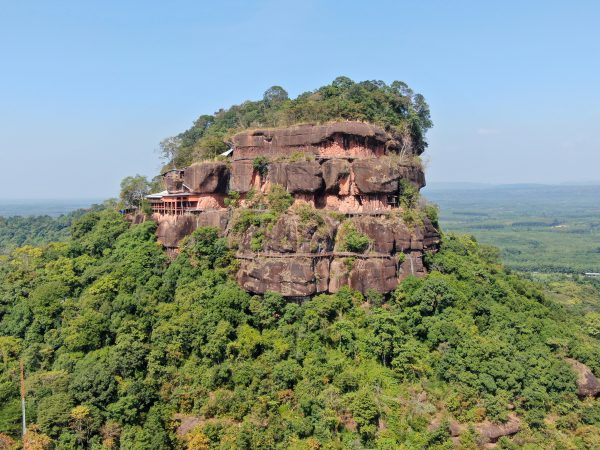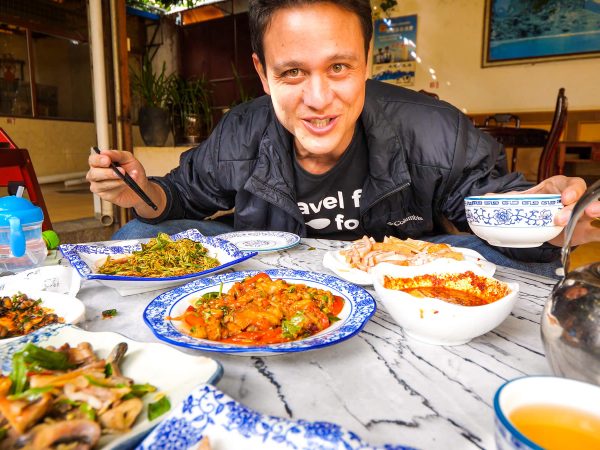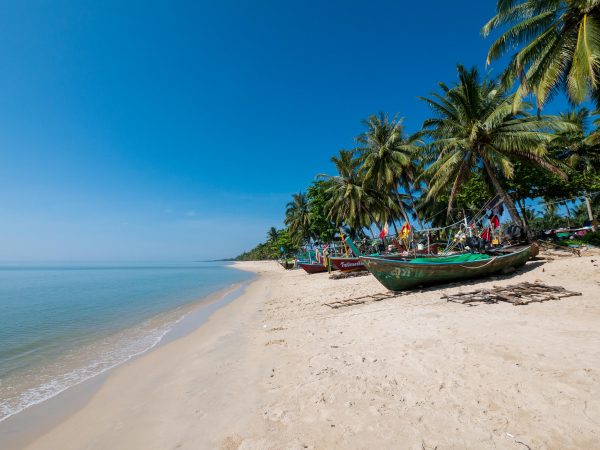

One of my favorite things to do is eat things I’ve never tasted before.
I love both foods that look familiar and that include familiar ingredients, and I also love to eat things that might be a little exotic, or perhaps bizarre.
One of the episodes for the Thai food TV show I’m filming, is about exotic Thai dishes… that’s why we ate pig’s blood soup and pig brains when we were in Chiang Rai.
In the Isan province (ภาคอีสาน) of Thailand, we had another day of exotic dining and food exploration…

What is huak (ฮวก)
In Isan they are called huak (ฮวก), in Thai they’re known as luk awd (ลูกอ๊อด ), and in English, they are tadpoles.
Frogs (กบ known in Thai as “gob”) are a significant part of the diet in many parts of Thailand.
Throughout Thailand you can order frog as a pretty standard protein in many different dishes, ranging from curried with chili, to deep fried, to stewed in jungle curry.

But in Thailand so far, I had only eaten full grown frogs, which as I mentioned are widely available throughout Thailand.
Consumed mostly in Isan, tadpoles are also popular, and are only available in the rainy season months (so they are seasonal and rare to find at times).
But first, let’s start at the beginning of the day…

Breakfast in Ubol Rat (อุบลรัตน์ pronounced Ubon Rat)
We first started the day with breakfast in Ubol Rat, and I had a bowl of tom sen (ต้มเส้น), basically mung bean glass noodles cooked in a chicken braised soup.

It was alright, but a little on the sweet side for me.
Nevertheless, I was pretty hungry in the morning, so it did hit the spot.

Ban Kham Pla Lai Village (บ้านคำปลาหลาย)
Just a few kilometers from Ubol Rat (อุบลรัตน์), we headed to a small village known as Ban Kham Pla Lai (บ้านคำปลาหลาย), to meet up with Paw Lae (พ่อแหล่), the head of the village.

Ban Kham Pla Lai (บ้านคำปลาหลาย) is a very small village, in the Khon Kaen area of Thailand, Ubol Rat, in the Isan region – it’s about a 7 – 8 hour drive to get there from Bangkok.

The village has been recognized as a model village in Thailand, a community that was formerly quite poor, and though no one is rich now, the basic needs of everyone living in the village are met.
As Martin Wheeler (a British man who lives in Ban Kham Pla Lai (บ้านคำปลาหลาย) explained to me, the village is basic, but everyone has access to resources, owns a house, owns land, and has access to fresh food including organic vegetables.

Ban Kham Pla Lai (บ้านคำปลาหลาย) is a village in Isan that’s a tight knit community, where people take care of each other and look after each other.

Many people grow their own crops, and many have their own livestock, not necessarily for sale, but at least for personal consumption.
It’s a simple life, but Ban Kham Pla Lai (บ้านคำปลาหลาย) is an example of a village in rural Thailand that went from being very poor to a community that’s not rich, but doing well.
Get exclusive updates
Enter your email and I’ll send you the best travel food content.

Introducing Paw Lae (พ่อแหล่)
Paw Lae (พ่อแหล่) is an amazing guy, and he’s the first person we went to meet in Kham Pla Lai (บ้านคำปลาหลาย) village.

Paw Lae (พ่อแหล่) is not only the head leader of the village, but he is also well known in the area for providing training to students about sustainable agriculture.
He is a legend in Khon Kaen, and it was an honor to meet him and to hang out (and eat) with him and his family for the day.

Along with growing a number of crops, and hosting training sessions for students, one of Paw Lae’s (พ่อแหล่) main projects is his frog farm, where he raises and sells frogs for food.
That’s what we were after.

As we were touring around Paw Lae’s (พ่อแหล่) compound, checking out his pigs and chickens, this jolly fellow came by, hungry for frog and ready to buy some.
We ended up scooping him some fresh frogs out of the pond and he bought 2 kilos. He said he was going to make tom yum gob (ต้มยำกบ), tom yum soup with frog – sounded pretty good to me.

After walking around the village for a bit, and seeing the frog farm, we then took off our shoes and headed straight into the tadpole pond to catch some tadpoles for a couple traditional, and exotic, Isan dishes we’d be cooking next.
Alright, now let’s get into the delicious food…

Deep fried tadpoles (ฮวกชุปแป้งทอด)
After catching the tadpoles, we then went on to cook 2 different dishes: mok huak (a little tadpole casserole wrapped into a banana leaf and grilled), and huak tod (deep fried tad poles).
The huak tod (ฮวกชุปแป้งทอด), deep fried tadpoles, were first coated in a batter made with flour, salt, and a hint of chili paste, then just deep fried.
They tasted like little boneless chicken nuggets, very tasty indeed.

Mok huak (หมกฮวก tadpole casserole)
But the mok huak (หมกฮวก) is what I was most interested in, quite an adventurous and exotic Thai dish.
In a bowl, we mixed up a combination of lemongrass, chilies, sweet basil, dill, and some other herbs and seasonings, along with a good handful of fresh tadpoles.
Then we filled the tadpole mixture into a few layers of banana leaves, and wrapped them up like a little package.

The mok huak (หมกฮวก) then sat on a low fire grill for about 10 minutes until they finished cooking.

How was the mok huak (หมกฮวก)?
Honestly speaking, the mok huak (หมกฮวก) was delicious.
If you’ve ever eaten frog before, you might agree with me that it’s delicious, but very boney. But tadpoles are like the best of the frog, without the bones.

They were like little pieces of boneless fish and chicken, and mixed with all the chilies, lemongrass, and herbs, it was fantastic, especially when eaten along with bites of sticky rice.

Mok dua daw (หมกตัวต่อ wasp larvae casserole)
In Chiang Rai, I ate wasp larvae for the first time, both straight out of the hive, and also pounded in a nam prik chili sauce.
In Isan, they made mok dua daw (หมกตัวต่อ), wasp larvae grilled in a banana leaf wrapper, and it was pretty good too.

The wasp larvae was mixed with a similar ingredient blend as the mok huak (หมกฮวก), with lemongrass, chilies, and herbs, but this version had an egg included as well.
The egg worked to hold all the ingredients together.

Isan is one of the great regions of Thailand for delicious cuisine, and this meal, including a few dishes I had never tried before (and a few dishes that are very rare to find in Bangkok), was excellent.

In addition, we also enjoyed a full lunch spread of dishes at Ban Kham Pla Lai (บ้านคำปลาหลาย), everything prepared by Paw Lae’s wife and his family.
Most of the dishes were frog based, in all forms and sizes, and we also had a few other assorted Isan dishes, all of which were very tasty.

Other lunch dishes
Sitting on an elevated bamboo platform, we all feasted on a properly delicious local Isan village feast.
There were some very interesting dishes, like the tadpole dishes, as well as a few Isan food classics.

Jing reet (จิ้งหรีด fried giant crickets)
Most normal crickets I’ve seen are about the size of big flies, but these were giant crickets, about the size of cockroaches, but meatier looking.
In the bowl, they were still alive and moving about.

In Thailand you’ll find vendors selling insects all over, and they are usually all quite tasty, but I can for sure say, these were much fresher, and natural tasting than ones I’ve eaten in Bangkok.
These fried giant crickets (จิ้งหรีดทอด) were really quite delicious, lightly salted, and crispy.

Gob tod gratiem (กบทอดกระเทียม)
Another dish we were served for lunch was deep fried frog, marinated in a bit of soy sauce and topped with lots of garlic.

It was basically like fried chicken, only with more bones and less meat. It sure was tasty.

Serious som tam (ส้มตำลาว)
Along with all of our plates of protein, an Isan meal would not be complete without a plate of the ubiquitous som tam (green papaya salad).
It was marvelous, and it was country Thai Isan style – fiery hot, fresh vegetables, and potently flavored with pla ra (fermented fish sauce) – delicious.

Goy het (ก้อยเห็ด)
Goy het (ก้อยเห็ด, could also be spelled koi), a mixture of sliced wood ear mushrooms cooked in an Isan dish known as goy (similar to lab, but a little different), was marvelous.
I had eaten goy neua (beef version, that’s a video) before, but never with wood ear mushrooms.
It was fantastic, again, nice and spicy, and sprinkled with a nice amount of khao khua, toasted pounded sticky rice.

Gai tom (ต้มไก่)
Another dish I enjoyed was gai tom (ต้มไก่), a soup of chicken boiled with herbs and some small vegetables. It was more of just a soothing light and country style Thai chicken soup.
Eating a proper style Isan lunch with the company of Paw Lae (พ่อแหล่) and his family was wonderful.
Happily stuffed, we continued on to our next scene.

Farm with Martin Wheeler (มาร์ติน วีลเลอร์)
After lunch we headed over to meet Martin Wheeler (มาร์ติน วีลเลอร์), a British man who lives in Ban Kham Pla Lai (บ้านคำปลาหลาย), and has a farm.
The reason he loves Isan and more specifically this village so much, is for the community, the access to resources, and the incredible hearts of the people.

It was an inspiration to meet Martin, a man that has a sincere heart for Isan.
After a wonderful day touring the wonderful Ban Kham Pla Lai village, and getting to eat a full meal of wonderful Isan dishes, we headed back to Khon Kaen city.

The hospitality of Paw Lae (พ่อแหล่) and his family, as well as Martin, was wonderful.
They all were amazing people and it was an honor to meet each and every one of them.

Conclusion
Eating “full-grown” frog is extremely common throughout Thailand, especially in the Isan province of the country… but there’s another stage of the frog that’s a little more exotic, and common in Isan as well: tadpoles (ฮวก huak)
In Khon Kaen (ขอนแก่น), I had the chance to visit Ban Kam Pla Lai (บ้านคำปลาหลาย), a small village in Isan, where I met Paw Lae (พ่อแหล่), the head leader of the village and an all around amazing man.
He raises frogs for food, and after we toured his farm, we then went fishing for tadpoles for lunch. We then prepared a dish known as mok huak (หมกฮวก) – kind of like a grilled tadpole casserole.
It was a huge honor to meet Paw Lae (พ่อแหล่) and his family, and I thoroughly enjoyed this local Isan food experience.
(NOTE: I’m part of a Thai food TV show documentary, where I’m traveling around Thailand eating unforgettable foods. I’m doing my best to blog about the things we do and eat. If you’re interested, check out the details here.)
Get exclusive updates
Enter your email and I'll send you the best travel food content.



